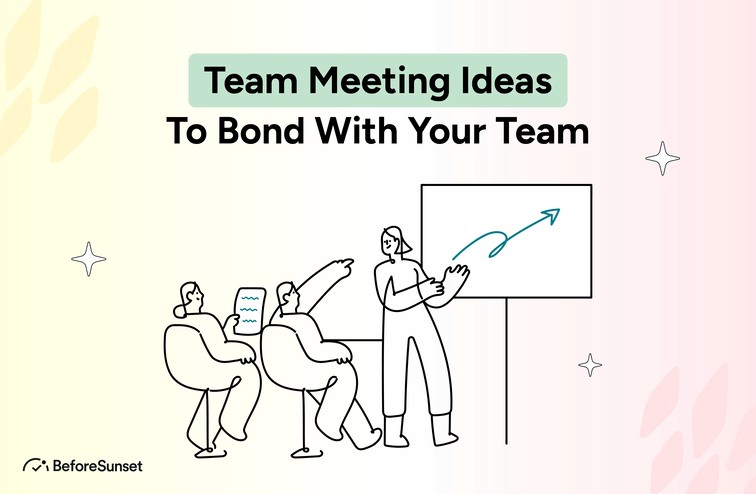Team meetings offer a special chance to promote a sense of cohesion and camaraderie among team members. These get-togethers may be converted into entertaining and engaging events that enhance the ties within a team, going beyond their conventional purposes of exchanging information and making choices.
In this blog "Team Meeting Ideas To Bond With Your Team," we will explore imaginative and engaging methods to make team meetings not only fruitful but also enjoyable and memorable.
Organizations and groups may create a more cohesive and motivated team by including creative ideas and activities in team meetings. This improves teamwork and helps teams accomplish shared goals with zeal and a sense of purpose.

Types of Team Meetings
Effective cooperation across businesses and project teams is based on team meetings. They act as an essential channel for communication, decision-making, and creating a sense of teamwork among team members. However given that they come in different shapes and are each customized to certain goals and objectives, team meetings are not all made equal.
Virtual Meetings
Virtual meetings are events held in a digital or online setting that allow remote teams to connect and communicate remotely using web-based platforms and video or audio conferencing capabilities. In the linked world of today, where they may provide benefits like geographical flexibility, cost savings, and time efficiency, they have grown in popularity.
When bringing together people from different geographical places, remote meetings are essential for facilitating effective communication, information exchange, and cooperation. However, they also come with difficulties, such as possible communication barriers and technological difficulties.
To get the most out of these digital meetings and improve productivity and connectedness in a work environment that is becoming more distant and international, an effective facilitator and a clear agenda are required.
In-Person Meetings
Meetings that take place in person are physical events that bring people together in the same place, face to face. They provide a special and direct way of communicating, allowing for rich non-verbal exchanges including eye contact and body language.
Meetings in person are ideal for establishing trustworthy relationships, encouraging conversation, and forging strong personal ties. They are especially useful in situations demanding crucial discussions, team development, and practical collaboration.
However, face-to-face conferences can be logistically difficult, necessitating frequent travel and adding to related costs. As seen by the growing popularity of virtual meetings, they may also be less practical in circumstances when participants are spread geographically or where immediate physical presence is not required.

Preparing for a Successful Meeting
The foundation of effective and efficient teamwork inside any organization or organization is meeting preparation. Effective meeting planning and execution may significantly impact obtaining intended results in a world where time is a valuable resource. Employee engagement is crucial for their professional development, and team morale because it sets the tone for future meetings.
No matter if the meeting is a simple team catch-up, a crucial decision-making meeting, or a brainstorming session, thorough planning makes sure that the gathering has a goal, engages participants, and produces valuable outcomes.
Choosing the Right Time and Place
A crucial component of a meeting's success is choosing the right time and place. It lays the groundwork for a successful meeting that promotes participation and reduces disturbances.
Timing: Take the availability and commitments of the main players into account. Avoid times when people are often busy or tired and pick a time that works for the majority. The meeting's goal may also have an impact on the timing. Early mornings or late afternoons may be suitable for regular updates, whereas mid-morning times when people are normally more attentive, may be preferable for crucial decision-making meetings.
Location: The actual location of the conference should support its goals. For formal conversations, presentations, or decision-making, a quiet, dedicated meeting space with the required technology is perfect. A shared workspace or even a virtual meeting platform may be used for more relaxed and productive meetings. Consider elements like proximity and transportation to make sure the site is convenient for all attendees.
Identifying Meeting Goals & Objectives
A crucial first step in making sure a meeting is effective and fruitful is identifying specific, well-defined goals and objectives. These objectives lay the groundwork for the whole meeting, directing conversations and maintaining participants' attention. Here are some crucial things to remember:
Identify the Goal: To begin, ask, "What is the goal of this meeting?" Is it to exchange information, reach choices, generate ideas, address issues, or create plans for the future? The ultimate goal must be made clear.
Specific Objectives: Break down the purpose into specific, measurable, and achievable objectives. What do you want to accomplish during the meeting? For example, if the purpose is to discuss a new project, the objectives might include reviewing project details, assigning responsibilities, and setting project milestones. Team meeting topics should be chosen to create lively discussions as it can become a team-building exercise.
Prioritize Objectives: Sort your goals by importance. Not all goals are equal. Set a priority for them to guarantee that the most important ones get the meeting's attention.
Communicate Goals: Make attendees aware of the meeting's goals in advance. This promotes active involvement by enabling people to arrive prepared and aware of the meeting's objectives.
Time Management: Give each goal the time it needs. This keeps conversations on topic and guarantees that all goals are covered throughout the specified meeting time.

Creating an Agenda & Stick to It
For a meeting to stay on schedule and stay focused on its goals and objectives, a well-structured agenda is crucial. The meeting agenda acts as a guide for the meeting, describing the subjects to be discussed, the time given for each item, and who will lead or participate in each discussion.
The agreement to follow this agenda throughout the meeting is equally crucial. This discipline makes sure that the talk stays on topic and stays on track, encouraging a constructive atmosphere. The meeting facilitator must enforce the agenda, gently directing attendees back to the predetermined themes if they stray.
Meetings are more likely to be meaningful, time-effective, and result-oriented when an agenda is set and followed.
Inviting the Right People
A meeting's success depends greatly on who you choose to invite. The people you invite should have a clear stake in the results of the meeting and be directly relevant to its aims and objectives. Ensure that participants have the information, skill, or authority needed to make decisions in order to contribute effectively.
Avoid inviting too many people because this might result in inefficiencies and decreased interest. If you are for example inviting a guest speaker make sure that the meeting attendees know who they are and this is a fun activity for them.
Consider diversity in your choice as well, since varied viewpoints may enliven debates and inspire more creative solutions. You may improve the meeting's relevancy, effectiveness, and overall impact while also honoring the participants' time and resources by selecting the attendees with care.

During the Meeting Tips & Ideas
The meeting's facilitator is essential to ensuring that it stays on course. actively lead the debate, ensuring that the objectives are achieved and that the agenda is followed. Encourage everyone to participate, use time wisely, and steer the topic toward the meeting's objectives.
Establish a setting where everyone feels at ease contributing. Encourage candid communication and attentive listening. Asking open-ended questions and encouraging comments are effective ways to engage people and elicit their views. Recognize and value their contributions.
Effective time management is crucial. Respect the time provided for each item on the agenda and refrain from allowing any one subject to take over the conversation. To ensure that participants are conscious of time restrictions, use timekeeping devices or a visible clock.
Assign someone to take notes throughout the meeting or utilize collaborative software to record important choices and action items. After the meeting, these documents are essential for accountability and reference.
If difficulties or disagreements come up during the meeting, deal with them in a positive way. Encourage participants to offer answers and discover points of agreement. Make sure conversations are civil and goal-oriented.
To improve comprehension and engagement, use visual aids like presentations, charts, or diagrams. Visual components may enhance communication and help people better understand complicated material.
Summarize the main conclusions, choices, and actions at the conclusion of the meeting. Send attendees the meeting minutes or a follow-up email that summarizes the discussion, the decisions made, and the next actions. This makes roles more clear and keeps everyone in the loop.
Take into account asking attendees for their opinions on how well the meeting went. This can assist in pinpointing problem areas and hone the strategy for upcoming sessions.
While adhering to the agenda is crucial, be prepared to be flexible when called for. When a worthwhile, spontaneous conversation emerges, decide whether to continue it or schedule it for a different meeting.
Try to end the meetings in a positive tone so that the entire team can have higher morale.
Facilitate Open Dialogue & Encourage Participation
Facilitating Open Dialogue:
Effective meetings must have open discourse facilitation. It entails fostering an atmosphere in which individuals feel free to communicate their ideas, opinions, and worries. The facilitator of the meeting should provide an inclusive and open atmosphere to accomplish this.
They might begin by reiterating that all viewpoints are important and that there are no right or incorrect responses. By maintaining eye contact, nodding, and providing vocal cues like "I understand" or "Could you please elaborate?" the leader may also promote active listening. This promotes participant trust and guarantees that all opinions are heard.
Encouraging Participation:
To generate a variety of ideas and achieve better results, active involvement in meetings is crucial. The meeting facilitator can use a number of techniques to achieve this. First, they ought to formally request feedback from those who might be less inclined to speak up.
To get input from everyone, they might also employ strategies like brainstorming or round-robin conversations. Leaders can also pose open-ended inquiries that need more information than a simple affirmative or negative response.
These inquiries invite more in-depth and deliberate answers. To show that each participant's work is valued, it's crucial to acknowledge and thank them for it. Meetings may be made more interesting and effective by fostering an environment of open communication and active participation.

Use Technology to Enhance Engagement
Technology provides a variety of interactive technologies that can greatly improve participation in meetings. For instance, polling software may be used to quickly get participants to comment on important subjects. This not only encourages participation but also offers decision-makers real-time data. Similar to this, collaborative online platforms like interactive whiteboards enable attendees to actively engage by exchanging ideas, working together to modify papers, or annotating visual assets, enhancing the meeting's energy and participation.
Through the use of VR and AR, participants may be transported into virtual settings, resulting in immersive and interesting meeting experiences. This is very helpful when working together on 3D models during training sessions. For instance, during a virtual meeting, a design team can utilize augmented reality (AR) to view and interact with a 3D prototype, making the information more interesting and useful.
Tools for video conferencing have become crucial for online and distant meetings. They make it possible for in-person conversations, which are more interesting than voice-only calls. Large-scale presentations and conversations may be held on webinar systems, which provide tools like Q&A sessions, chat rooms, and audience polls to keep attendees engaged.
Meetings and presentations may use gamification aspects to increase interest. Meetings may be made more engaging and enjoyable by incorporating gamified quizzes, challenges, or team contests relevant to the meeting's topic. This will motivate attendees to remain interested and attentive.
Breakout room capabilities are available on many virtual conference platforms, enabling participants to divide into smaller groups for discussions or activities before returning to the main meeting. This encourages more personal and active discussion, which makes bigger gatherings less scary and more interesting.
Participants can connect with one another during virtual meetings by using live chat and discussion boards to exchange questions and ideas. This generates continual, dynamic discourse and encourages real-time interaction.
It is crucial to make sure that everyone can participate in the meeting's content. Meetings may be made inclusive and entertaining for all participants by utilizing technology to enable accessible features like real-time captioning, sign language interpretation, and screen reader compatibility.
Connect With Your Team In Real Time
With BeforeSunset AI's up-and-coming team function, being in communication with your team has never been easier. Until then you can be the master of productivity, all you have to do is to try BeforeSunset AI for free.


